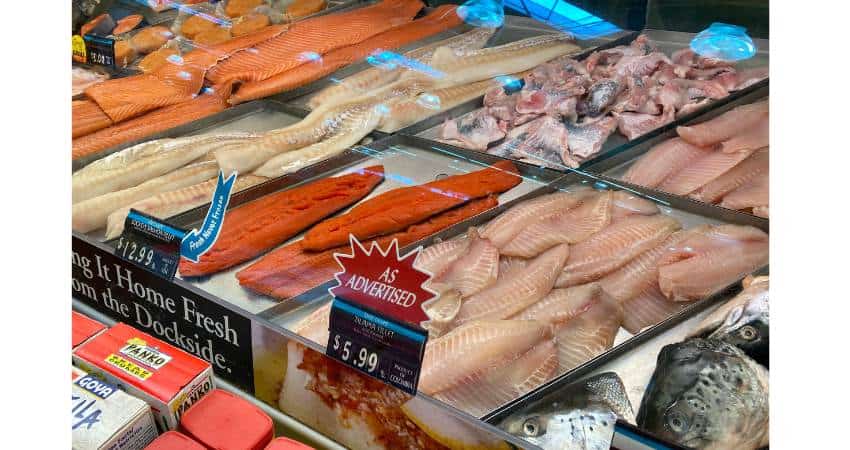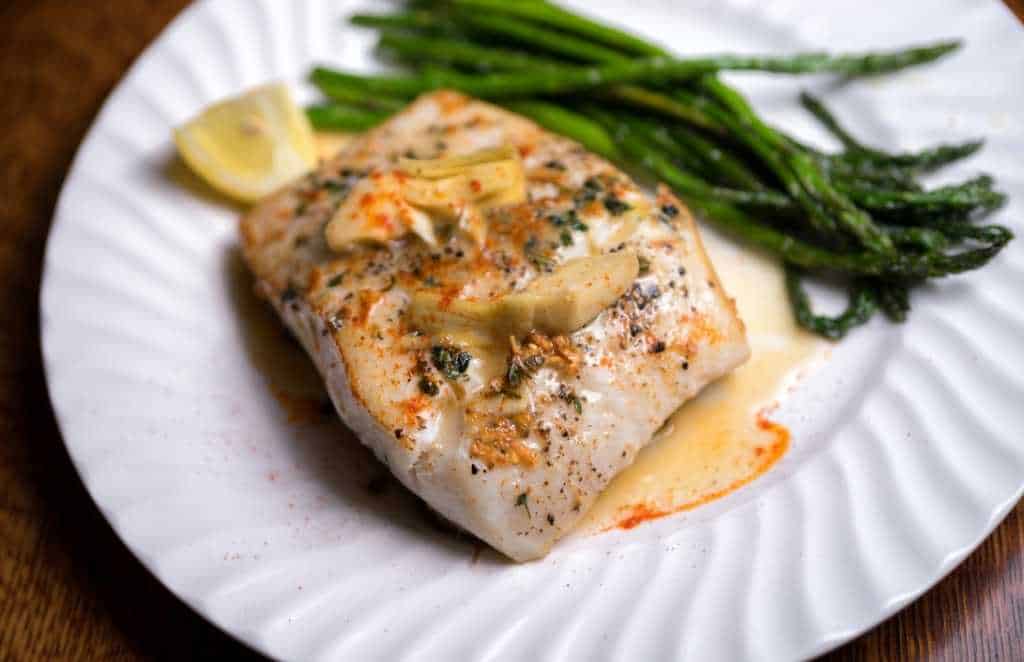Mahi Mahi vs Halibut: What’s The Difference? Fish Comparison
Mahi Mahi and halibut are often compared due to their similar textures. Although there are various differences leading many people to ask about the two fish. Therefore, let’s answer the question, What is the difference between Mahi Mahi and halibut?
Mahi Mahi and halibut are different species even though they are from the same family and genus. Halibut provide a higher percentage of nutrients than Mahi Mahi. Mahi Mahi has a stronger taste and is less flakey than halibut. Halibut costs approximately $10 more per pound than Mahi Mahi.
This article will compare their tastes, textures, cooking methods, costs, mercury levels and whether one can substitute for the other in recipes. In addition, I’ll do a side-by-side comparison of their nutrients, habitats, size, weight and more.
Mahi Mahi and Halibut Nutritional Value
The following table is a side-by-side comparison of all the nutrients per four ounces:
| Nutrient | Halibut, raw (4 Ounces) | Mahi Mahi, raw (4 Ounces) |
| Calories | 103 | 96 |
| Fat | 1.5 g | 0.8 g |
| Saturated Fat | 0.3 g | 0.2 g |
| Cholesterol | 56 mg | 83 mg |
| Protein | 21 g | 21 g |
| Omega-3 | 0.25 g | 0.13 g |
| B-6 | 0.6 mg | 0.4 mg |
| B-12 | 1.2 mcg | 0.6 mcg |
| Thiamin | 0.05 mg | 0.02 mg |
| Riboflavin | 0.03 mg | 0.07 mg |
| B5 | 0.3 mg | 0.8 mg |
| Niacin | 7.3 mg | 6.9 mg |
| Folate | 13.6 mcg | 5.6 mcg |
| Iron | 0.1 mg | 1.2 mg |
| Potassium | 493 mg | 471 mg |
| Magnesium | 26 mg | 34 mg |
| Phosphorus | 267 mg | 162 mg |
| Calcium | 7.9 mg | 17.0 mg |
| Zinc | 0.4 mg | 0.5 mg |
| Selenium | 51.7 mcg | 41.3 mcg |
Nutrient sources ((Nutrition Value: Fish, raw, Atlantic and Pacific, halibut))1
After examining the nutritional table above, it’s easy to see both fish contain many vitamins and minerals. Therefore, let’s examine which one is healthier.
Halibut is healthier than Mahi Mahi due to its higher percentage of heart healthy omega-3 fatty acids and B vitamins. It provides more B6, B12, thiamin, niacin, folate, potassium, phosphorus, and selenium than Mahi Mahi.
Mahi Mahi is no slouch and is healthy also. It provides more riboflavin, B5, iron, magnesium, calcium and zinc.
Halibut contains about double the omega-3 fatty acids which separate the two. Keep reading the next section to find out why omega-3 fatty acids are beneficial for health.
MahiMahi and Halibut Health Benefits
Both fish provide the same nutrients and therefore the same benefits. Although I broke down the benefits by which fish offers the higher percentage of each nutrient ((FDA: Seafood Nutrition Facts)).
Since omega-3 fatty acids are similar, I’ll start with them first.
Halibut Health Benefits
Omega 3 Fatty Acids
Halibut provides 0.25 grams of omega-3. Why does omega-3 fatty acids matter so much?
It’s because omega-3 fatty acids are heart healthy and help keep arteries healthy. The omega-3s in halibut may help with the following:
- Keeping bad cholesterol low.
- Keeping good cholesterol high.
- Reducing inflammation.
- Reducing plaque build-up.
- Lowering triglycerides
- Help keep the heart rhythms more normal.
DHA and EPA, two of the fatty acids, are associated with lowering blood pressure and improving the health of blood vessels ((National Center for Biotechnology: Marine Omega-3 Supplementation and Cardiovascular Disease)).
Studies suggest omega-3s can help reduce joint pain and stiffness in people with rheumatoid arthritis. They may also boost the effectiveness of anti-inflammatory drugs.

Fats
Both fish are very low in saturated fat. The polyunsaturated fat, monounsaturated fat and total fat is considered healthy like most fish. Typically fats and glycemic index are nothing to worry about with healthy fresh fish.
B Vitamins
The B vitamins provided include B1 (thiamin), B2 (riboflavin), B3 (niacin), B9 (folate) B6, B12 and B5. B vitamins help support the following:
- Energy levels.
- Red blood cells.
- Cardiovascular disease.
- Digestion.
- Nerve function.
- Brain function.
Phosphorus
Phosphorus has been shown in scientific research to help with the following:
- Muscle recovery after exercise.
- Muscle contraction.
- Help the body store and manage energy.
- Help the kidneys remove waste.
- Promote healthy nerve conduction.
- Promote teeth and bone strength.
Selenium
Selenium is a nutrient which doesn’t receive much press. I’m unsure why many don’t write about it more because studies2 show selenium may help to protect the following:
- Heart disease
- Thyroid
- The immune system
- Cognitive issues
Potassium
Potassium helps the body get rid of excess sodium which helps reduce fluid build-up. These help keep systolic and diastolic blood pressure lower ((American Heart Association: How Potassium Can Help Control High Blood Pressure)).
The more potassium you consume, the more sodium your body will lose. Consuming too much sodium or a diet low in potassium throws off the delicate balance the kidneys need to remove the excess water3.
According to Harvard Health, a number of studies have shown a connection between low potassium levels and increased blood pressure4.
If you’re wondering how it compared to cod, check out my comparison article.
Mahi Mahi Health Benefits
Calcium
Calcium is important for blood pressure and the heart.
Harvard Health reports calcium helps maintain blood pressure because it helps to control the relaxing and tightening of blood vessels5.
Calcium also helps the following:
- Build and maintain strong bones.
- Muscles need calcium to function properly.
- Improve nerve function.

Magnesium
There are 34 mg of magnesium per four ounces. Magnesium calms and relaxes the whole body including blood vessels. Magnesium has been shown to help improve sleep related problems like insomnia ((National Institutes of Health: Magnesium)).
Magnesium helps keep blood pressure levels balanced and stable. A recent study researched 22 studies and concluded magnesium supplementation decreased diastolic and systolic blood pressure6.
Magnesium helps control muscle and nerve function, blood sugar and blood pressure. In the muscles and heart, magnesium competes with calcium to help the muscles relax after contracting.
When the body is low in magnesium, calcium can over stimulate the heart muscle’s cells causing a rapid or irregular heartbeat.
Halibut and Mahi Taste and Textures
One of the most important things people takes into consideration when choosing a fish in the store or fishing is its taste. When comparing the two fish, Mahi Mahi vs halibut, let’s examine how they taste.
Mahi Mahi tastes a little stronger and fishier than halibut. Although their tastes are both mild to sweet and are similar. They both have a firm texture although halibut is slightly flakier.
Mahi Mahi taste can range from mild flavor to sweet depending which part of the flesh you’re eating. The darker area has a more pronounced flavor similar to swordfish but not as much. Its firm, moist texture has large flakes.
Halibut has a mild to sweet flavor taste. It is typically a thicker cut of fish and has a firm texture and a little flaky.
I did some original research on taste by polling my clients, readers and members of food groups. I asked, which fish tastes better?
- 61% said they preferred halibut.
- 39% said they preferred Mahi-mahi.
To conduct more research on taste I set up a blind taste test at home. Both were cooked and seasoned the same way. The results mirrored the poll above.
I compared everything between Mahi fish and tuna including their tastes. Check out my recent article here.
Substitutions
When preparing recipes for dinner it’s not always possible to locate the type of fish in store or while fishing. If you have only one type of white fish, you may wonder if you can substitute one fish for the other.
Halibut can substitute for Mahi Mahi due to their similar textures and tastes, although Mahi mahi’s flavor is slightly stronger. They both have a firm enough texture allowing similar cooking methods when substituting. Both of them can be grilled, baked, roasted, poached, fried or seared.
Other halibut substitutes include the following:
- Rainbow trout
- Cod
- Flounder
- White or black sea bass is the most likely substitute.
The best Mahi Mahi substitutes are:
- Salmon
- Striped bass
- Cod
- Rainbow trout
- White Sea bass
- Tuna
When substituting either one always stick to the following:
- Same size and weight.
- Stick with similar fillets, whole fillet or cross section.
- Stick with skinless or skin when the recipe calls for one.
- Texture is more important for certain cooking methods. Like using a firmer texture when grilling7.
Check out substitutions and a complete comparison with salmon in my article, Salmon: Which is Better?
Cost
The costs for fish will vary depending on how they’re are caught fishing and where they are sold. When purchasing fish, be sure to check the label to see if it is wild-caught or farm raised. Therefore, let’s take a close look and find out which one is more expensive.
Halibut is more expensive than Mahi Mahi. The average cost for wild caught Mahi Mahi is $18.99 per pound while the average cost for wild caught halibut is $29.99 per pound.
I conducted original research on costs by checking various different stores and their prices.
First, I checked the local Freshdirect online supermarket for the current prices.
- Wild Mahi Mahi fillet
- $18.99 per pound
- Fresh, wild halibut fillet
- $29.99 per pound
I also checked shoprite supermarket:
- Fresh wild halibut fillet
- $36.99 per pound
- Farm Mahi mahi
- $9.99 per pound

Mercury Levels
The EPA and The FDA have issued warnings and suggestions regarding mercury levels in fish and how often they should be consumed8. This is especially important for young infants, developing children and pregnant women.
They established a list of best fish, good choices and ones to avoid based on their mercury levels.
Mahi Mahi and halibut have similar levels of mercury. They are both listed on the FDA’s good choices of fish to consume regarding their mercury levels.
Everyone, especially if you’re pregnant, breast feeding or have a young child, always check with a physician prior to eating new foods or changing your dietary habits.
These mercury warnings can change over time or affect only a particular area or state. For eight bass or any fish, check with your local EPA and FDA for the current recommendations especially if you’re fishing9.
Mahi Mahi vs Halibut: Habitats, Size, Weight, Appearance?
How can you tell the difference between the two fish?
The easiest way to tell the difference between a Mahi Mahi and a halibut is their body shape and colors. Halibut is a large flat fish and Mahi Mahi is compressed and elongated. Halibut have a dark top and lighter colored bottom. Mahi Mahi are electric greenish near the top and golden-yellow on the bottom and tail.
Scientific Classifications, Families, Species
Mahi Mahi are from:
- Family: Coryphaenidae
- Genus: Coryphaena
- Species: C. hippurus
- Common nicknames: Dolphinfish, dorado.
Halibut have two species of fish both from the same family and genus.
Pacific halibut:
- Family: Pieuronectidae
- Genus: Hippoglossus
- Species: H. stenolepis
Atlantic halibut:
- Family: Pieuronectidae
- Genus: Hippoglossus
- Species: H. hippoglossus
Habitats
- According to the National Oceanic and Atmospheric Administration, Pacific halibut primarily live in the Central Gulf of Alaska near Kodiak Island. Deep-sea fishing for them is a popular sport in Alaska.
- Atlantic Halibut are native to the temperate and arctic waters of the northern Atlantic Ocean. They can be found in Labrador, Greenland, Iceland, Bay of Biscay and Virginia.
Mahi Mahi can be found worldwide. Some of the common places include the following:
- The west coast of North and South America
- Hawaii
- The Atlantic coast of Florida and Africa
- The Gulf of Mexico
- The Pacific coast of Costa Rica
- Indian Ocean
- South China Sea
- Southeast Asia
- Caribbean
Approximately one-third of the U.S. Mahi-Mahi comes from the Atlantic Ocean, Gulf of Mexico and the Caribbean. The remaining comes from the Pacific Ocean near Hawaii.
Colors
- The upper part of halibut is dark and varies due to the color changing to blend in with the ocean floor. The change in color helps them avoid detection. The underside is lighter.
- Mahi-Mahi is an electric greenish blue towards the top. The lower body is goldfish and the tail appears yellowish.
Appearance
- Halibut have diamond shaped more elongated bodies than other flat fish. They have large arches in the lateral line over the pectoral fin. Their tails are crescent shaped. Both of their eyes are on the darker, upper side of their body.
- The Mahi Mahi adult males have a square head while the females have a rounded head. The have about 55-66 dorsal fin rays extending from the head almost to the tail. Their bodies are more compressed.

Size and Weight
- Then Atlantic Halibut female can grow up to 600 pounds. The males average 25-30 pounds and can weigh up to 100 pounds.
- A 20″ weighs about 3 pounds.
- A 36″ weighs about 20 pounds.
- A 58″ weighs about 100 pounds.
- Mahi-Mahi grow an average 39″ in length and weighs 15-29 pounds.
Age
- A halibut can live up to 50 years.
- Mahi Mahi lives up to 5 years but seldom exceed 4 years.
Diet
Mahi-Mahi consume the following:
- Juvenile tuna
- Small pelagic fish
- Billfish
- Pompano
- Invertebrates
- Bottom living species
Halibut consume the following:
- Other fish
- Cod
- Haddock
- Herring
- Sand eels
- Pogge
- Large crustaceans
As a Certified Health Coach, many of my clients inquire about seafood. In addition to coaching clients about Mahi Mahi and halibut, I’ve purchased, researched and consumed both fish for over 20 years.
If you have any questions about this article or other posts, don’t hesitate to email the details to us. You can find an email on our contact page. We’ll do our best to reply as soon as possible.
Read Next – More Fish vs Fish Articles!
Cod vs Mahi Mahi – What’s The Difference? Let’s Compare
White Perch vs White Bass: Which Is Better?
Sea Bass vs Salmon: Which Is Better?
Anchovies vs Sardines – What’s The Difference? Let’s Compare
Alaska Pollock vs Atlantic Pollock: Which Is Better?
Brook Trout vs Brown Trout – Let’s Compare The Differences
- Nutrition Value: Fish, raw, mahimahi [↩]
- National Institutes of Health: Selenium [↩]
- National Center for Biotechnology Information: The Effect of the Sodium to Potassium Ratio on Hypertension Prevalence: A Propensity Score Matching Approach [↩]
- Harvard Health: Potassium lowers blood pressure [↩]
- Harvard Health: Key minerals to help control blood pressure [↩]
- National Center for Biotechnology Information: Effect of magnesium supplementation on blood pressure: a meta-analysis [↩]
- Sea Grant North Carolina: Fish Flavors and Substitutions [↩]
- FDA: Advice about Eating Fish [↩]
- National Center for Biotechnology Information: Mercury accumulation in largemouth bass (Micropterus salmoides) in a Florida lake [↩]
